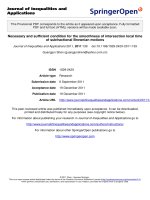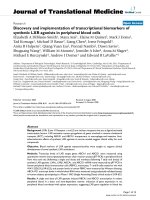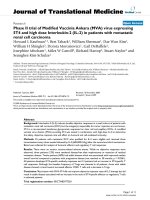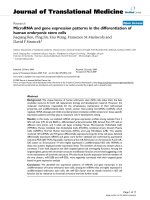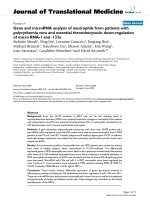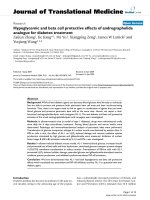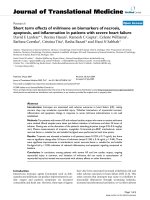báo cáo hóa học:" Correlation and comparison of Risser sign versus bone age determination (TW3) between children with and without scoliosis in Korean population" doc
Bạn đang xem bản rút gọn của tài liệu. Xem và tải ngay bản đầy đủ của tài liệu tại đây (1.16 MB, 8 trang )
BioMed Central
Page 1 of 8
(page number not for citation purposes)
Journal of Orthopaedic Surgery and
Research
Open Access
Research article
Correlation and comparison of Risser sign versus bone age
determination (TW3) between children with and without scoliosis
in Korean population
Hitesh N Modi, Chetna H Modi, Seung Woo Suh*, Jae-Hyuk Yang and Jae-
Young Hong
Address: Scoliosis Research Institute, Department of Orthopedics, Korea University Guro Hospital, Seoul, Korea
Email: Hitesh N Modi - ; Chetna H Modi - ; Seung Woo Suh* - ; Jae-
Hyuk Yang - ; Jae-Young Hong -
* Corresponding author
Abstract
Background: Most studies comparing the Risser staging for skeletal maturity are representing the
American or European standards which are not always applicable to Asian population who have
relatively less height and body mass. There is no article available that compares the Risser sign and
bone age correlation between patients with idiopathic scoliosis and patients without scoliosis.
Materials and methods: To analyze and compare the skeletal age with the Risser sign between
scoliosis and non-scoliosis group, a cross-sectional study was done in 418 scoliosis (untreated,
bracing or surgically) and 256 non-scoliosis children of Korean origin. Relationship was found in
both groups using Pearson correlation test.
Results: In scoliosis group, Pearson correlation exhibited significant correlation (p < 0.01)
between Risser sign and chronological age (r
2
= 0.791 for girls, 0.787 for boys) and Risser sign and
TW3 age (r
2
= 0.718 for girls, 0.785 for boys). Non-scoliosis group also showed significant
relationship (p < 0.01) between Risser sign and chronological age (r
2
= 0.893 for girls, 0.879 for
boys) and Risser sign and TW3 age (r
2
= 0.913 for girls, 0.895 for boys). Similarly, comparing Cobb
angles of each patient according to their Risser staging, exhibited that if scoliosis remains untreated
Cobb angle will increase with the increase in their Risser staging (r
2
= 0.363 for girls, 0.443 for boys;
p < 0.01).
Conclusion: Our results showed that chronological age is equally as reliable as skeletal age
method to compare with Risser sign, and therefore, we do not mean to imply that only the Risser
sign compared with skeletal age should be considered in the decision making in idiopathic as well
as non-scoliosis patients of Korean ethnicity. Concomitant indicators such as menarchal period,
secondary sex characteristics, and recent growth pattern will likely reinforce our data comparing
Risser sign with skeletal age in decision making.
Published: 20 September 2009
Journal of Orthopaedic Surgery and Research 2009, 4:36 doi:10.1186/1749-799X-4-36
Received: 29 March 2009
Accepted: 20 September 2009
This article is available from: />© 2009 Modi et al; licensee BioMed Central Ltd.
This is an Open Access article distributed under the terms of the Creative Commons Attribution License ( />),
which permits unrestricted use, distribution, and reproduction in any medium, provided the original work is properly cited.
Journal of Orthopaedic Surgery and Research 2009, 4:36 />Page 2 of 8
(page number not for citation purposes)
Introduction
Prognostic studies related to the risk of curve progression
in patients with idiopathic scoliosis (IS) have been ham-
pered by poor measurements of skeletal maturity and
arbitrary definitions of curve progression. Literature [1]
described a number of potential skeletal maturity indica-
tors, including Risser sign, the Oxford stage, The Greulich
and Pyle (GP) and Tanner-Whitehouse-III (TW3) matu-
rity assessments, and a number of serological skeletal
maturity markers in girls with idiopathic scoliosis. Using
the hand-wrist radiographs, there are two possible analy-
sis schemes are defined for the TW3 method. The first one,
named RUS, uses 13 bones (the phalanges, radius, and
ulna). The other one uses 20 bones (the 13 bones previ-
ously defined and the 7 bones of the carpal region). We
have chosen to build a method based on the 13 RUS
bones, because the carpal region is not valid after a certain
age [2]. Tanner-Whitehouse composite scores are based
on osseous stages and events at each level. The Tanner-
Whitehouse method involves measuring individual bone
parts to create an index value which was matched with
prepared table for both male and females to find out their
bone age. Senders et al [1] identified that Tanner-White-
house-III RUS skeletal maturity assessment [2,3] method
is the most closely related to curve behavior, or, more spe-
cifically, to the timing of curve take-off in early adoles-
cence, which is termed the curve acceleration phase
(CAP). Similarly Wang et al [4] proved that digital bone
age assessment (DSA) is a reliable indicator for predicting
residual spinal growth potential in idiopathic scoliosis
patients, but it should be correlated with menarchal status
and chronological ages.
Assessing the skeletal maturity in patients with adolescent
idiopathic scoliosis often gives the guideline for the treat-
ment regarding bracing weaning time or surgical consid-
eration. Since chronological age is not an accurate
predictor of the maturity, there are several methods have
been described in the literature to find out skeletal matu-
rity. However, none of those is proved to be accurate
enough to predict the residual growth potential of the
spine in idiopathic scoliosis. Risser sign is used most fre-
quently to assess the growth of the patient in relation to
clinical problems since it was described by Risser in
1958[5]. Although the Risser sign is still an acceptable
prognostic sign in the evaluation of IS patients, there is
considerable controversy about its reliability for predict-
ing the cessation of vertebral growth [6-11]. Binodi et al
have correlated Risser sign with bone age in 111 patients
with adolescent idiopathic scoliosis for assessing the
maturity [7]. This study did not have enough number of
patients in all groups, and they used the Greulich-Pyle
method for bone age assessment. Additionally most of the
studies are representing the American or European stand-
ards which we think not always applicable to Asian popu-
lation who have relatively less height and body mass.
There is no article available that compares the Risser sign
and bone age correlation between patients with idio-
pathic scoliosis and patients without scoliosis.
In present paper, we correlated Risser sign with chrono-
logical and skeletal age measured with Tanner-White-
house-III method in our study population with Korean
ethnicity. Our aim was to establish the skeletal average
age, both in male and females that correlates with the
Risser sign the most. In addition we also compared this
correlation between the patients with idiopathic scoliosis
and without scoliosis to find out if there is any difference
exists.
Materials and methods
We have analyzed skeletal age and Risser sign with their
Cobb angle in 418 patients with idiopathic scoliosis (IS)
and 256 patients without scoliosis (control). All the
patients with scoliosis and without scoliosis were grouped
into group1 and group2, respectively. All patients selected
for this study had an age between minimum 9 and maxi-
mum 16 years for girls, and minimum 9 and maximum
17 years for boys. Average age was 13.52 years (range, 9-
17) and 13.97 years (range, 9.1-17) for group1 and 2,
respectively. There were 95 boys and 323 girls in group1
and 140 boys and 116 girls in group2. Bone age determi-
nation was done by analyzing left hand posteroanterior
(PA) radiogram using TW3 [3] method. All radiograms
were taken after obtaining an informed consent from
patients and their parents and explaining them the pur-
pose of our study. Specific care was taken that in both
groups the date of wrist radiogram, pelvis radiogram
(showing Risser sign) and spine (showing Cobb angle)
were the same to prevent any biased result. Those radio-
grams that did not fulfilled all these criteria were excluded
from the study. All radiograms were taken by a single radi-
ologist on single radiogram machine to avoid errors
regarding patient positioning and distance from the X-ray
tube. All patients in group1 did not have any bracing or
operative treatment while taking the radiogram and calcu-
lating Cobb angle. Risser sign represents progressive mat-
uration of the iliac crest apophysis [5]. In the AP
radiographic projection of the pelvis, Risser sign was eval-
uated for all patients. Similarly, Cobb angle for the
patients in group1 was calculated using Cobb method on
AP radiogram of whole spine. All skeletal age assessment,
Cobb angle measurement and Risser sign evaluation were
done separately by two fellows who were familiar with all
measurement techniques. All measurements were done
on stored digital radiograms using picture-archiving and
communication system (PACS).
Skeletal age was subsequently compared with iliac crest
apophysis maturation (Risser sign) to determine the relia-
Journal of Orthopaedic Surgery and Research 2009, 4:36 />Page 3 of 8
(page number not for citation purposes)
bility of Risser sign as it correlates to the skeletal age deter-
mination by TW3 method. Similarly, chronological age
were also compared with the Risser staging and Pearsons
correlation coefficient graph was plotted to find out any
difference from chronological age to TW3 bone age. Com-
parison was done in both the groups to find out any dif-
ference in patients with scoliosis from in patients without
scoliosis. Additionally skeletal age and Risser sign were
also compared according to severity of curve and gender
in entire patients group to find any relation. Linear regres-
sion curve was plotted to compare various variables with
the Risser sign and skeletal age assessment.
Results
Table 1 shows average chronological and TW3 skeletal
age, and numbers of patients having Risser staging 1 to 5
respectively in group1 along with their average Cobb
angles. Analyzing our results using Pearson correlation
coefficient test, it showed value r
2
= 0.791 and 0.718 while
comparing Risser sign with chronological and TW3 age,
respectively in girls with scoliosis; and it was found to be
r
2
= 0.787 and 0.785 for boys with scoliosis. Similarly in
group2, results showed value r
2
= 0.893 and 0.913 for
girls; and 0.879 and 0.895 for boys, comparing bone age
versus Risser sign and Chronological age versus Risser
sign, respectively. Our results showed that TW3 method is
as reliable as chronological age to compare with Risser
sign in both the groups. When all values were compared
combined for both genders, r
2
= 0.775 and 0.712 for
chronological and bone age, respectively in group1 and r
2
= 0.841 and 0.854 in group2 which suggested that both
methods are equally reliable to correlate the Risser sign in
scoliosis as well as non-scoliosis patients to consider the
skeletal maturity. Additionally comparing the average
chronological age with the average bone age according to
the Risser sign in group1, there was no significant differ-
ence found for girls (p = 0.91), for boys (p = 0.98) and
combined (p = 0.93) in patients with scoliosis (Fig 1, 2).
Similarly in group2 it also did not exhibit any significant
difference for girls (p = 0.49), boys (p = 0.69) and com-
bined (0.44) population which showed that average val-
ues of bone age in each patient is the same with their
chronological age in these population (Fig 3, 4). Addi-
tionally when we compared the Cobb angles of each
patient according to their Risser staging using Pearson cor-
relation coefficient r
2
found to be 0.363, 0.443 and 0.383
for girls, boys and combined population, respectively
which exhibited that if scoliosis remains untreated Cobb
angle will increase with the increase in their Risser staging
(Fig 5).
Discussion
The Risser sign has been and is still used commonly by
orthopedic surgeons as a guide to the initiation or cessa-
tion of brace treatment, and the indication for surgery
[12,13]. The reason for using the Risser sign as a measure
of skeletal maturity is that the chronological age of the
patient is assumed to be inaccurate. Additionally it is read-
ily available on good anteroposterior standing radiogram
of spine while evaluating the patients with scoliosis.
Therefore it is better to correlate the reliability of Risser
sign with skeletal age to find out the average skeletal age
of the Risser sign in the population. Most literature corre-
lated the skeletal age with the Risser sign in American or
European children, however, no literature has been
reported for Asian population in which comparing the
Risser sign with skeletal age is not reliable. The purpose of
this study was to evaluate the correlation between the
Risser sign with skeletal age measured by TW3 method,
and also to compare the reliability of skeletal age with that
of chronological age in Korean population. Using the con-
trol group in our study we also aimed at to find out the
Table 1: Values of TW3 bone age and chronological age according to their Risser staging with their Cobb angle in idiopathic scoliosis
patients (group1).
Sex Risser Stage No of Pt Age SD r
2
value Bone age SD r
2
value Cobb SD r
2
value
Female 0 17 10.76 1.03 0.791* 10.86 1.43 0.718* 19.41 8.12 0.363*
1 44 11.72 1.35 11.81 1.51 20.22 8.73
2 44 12.72 0.97 13.26 0.96 24.72 11.69
3 85 13.31 1.05 13.45 0.93 23.34 9.62
4 93 14.47 1.03 14.16 0.85 24.43 11.47
5 40 16.15 0.86 14.93 0.21 34.95 12.8
Male 0 10 11.2 1.98 0.787* 11.26 1.98 0.785* 21.9 23.57 0.443*
1 8 11.37 2.26 11.46 2.36 15.75 6.88
2 9 13.33 2.39 13.33 1.54 15.22 6.79
3 19 15 0.94 15.1 0.97 31 13.16
4 33 15.69 0.98 15.88 0.86 34.03 10.79
5 16 16.62 1.02 16.05 0.99 38.06 16.53
r
2
values are explained by Pearson correlation coefficient test.
* Suggestive of p value < 0.01.
Journal of Orthopaedic Surgery and Research 2009, 4:36 />Page 4 of 8
(page number not for citation purposes)
difference, if exists, the appearance of the Risser sign and
skeletal age in scoliosis patients from control patients
(without scoliosis) of the same ethnicity. We believe that
this is the first study comparing such difference among
scoliotic and non-scoliotic groups.
Binodi et al [7] found that the correlation coefficient of
the Risser stage versus skeletal age was 0.56 for girls while
Scoles et al [10] found it to be 0.81 for Risser stage versus
chronological age. Thus they using these methods, chron-
ological age provides a more accurate measure of skeletal
age than the Risser sign. Both of these studies were done
using Greulich Pyle method. While Dhar et al [8] com-
pared Risser stages with skeletal age using TW2 atlas [14].
Here in present study we have used TW3 method to find
out relationship between the Risser sign and skeletal age
in Korean population. We also tried to estimate general
appearance of the Risser sign according to skeletal age in
Korean population aiming to make a baseline data for this
population. We found that the comparison of the Risser
staging versus chronological age and the Risser staging
versus TW3 bone age in both groups (with scoliosis and
without scoliosis) did not differ from each other. Our
study proved that that there is no difference on appear-
ance of the Risser sign based on the presence or absence of
idiopathic scoliosis in Korean population. We, however,
agree that the correlation of Risser sign with chronological
and TW3 bone age in non-scoliosis group had a little
higher reliability than that of scoliosis group. However,
this difference of the chronological and TW3 bone age was
Correlation of the skeletal age and bone age (TW3 method) were plotted against the Risser sign for girls and boys separately in idiopathic scoliosis group (group1)Figure 1
Correlation of the skeletal age and bone age (TW3 method) were plotted against the Risser sign for girls and
boys separately in idiopathic scoliosis group (group1). Values r
2
denotes the Pearson correlation coefficient value that
suggested that TW3 bone age measurement is equally reliable with chronological age while comparing with the Risser sign for
skeletal maturity.
Journal of Orthopaedic Surgery and Research 2009, 4:36 />Page 5 of 8
(page number not for citation purposes)
not statistically significant between group 1 and 2 (p >
0.05).
Assessment of skeletal maturity is necessary in the man-
agement of children with skeletal growth abnormalities
and in the decision making of the other deformities like
scoliosis. It is quite difficult to determine developmental
maturation of children from statural height, weight and
chronological age [15]. Recently Wang et al [4] compared
histological examination of superior and inferior end-
plates of vertebral body and compared them to digital
skeletal age (DSA) to identify residual growth potential of
spinal column in 39 Chinese girls. Their histological grad-
ing of the endplates showed that DSA is a more reliable
indicator than menarchal status or chronological age for
predicting the spinal residual growth potential in idio-
pathic scoliosis patients. However, histological grading is
not possible in routine clinical practice, rather impractical
to find out maturity level. And as per their conclusion, we
also used DSA to identify skeletal maturity and that was
compared with the Risser sign to establish the average
range of DSA using TW3 method in Korean population.
Additionally we have compared both genders in our study
in both groups with and without scoliosis, and we found
that the range and the mean age for the appearance of the
Risser sign were similar in boys and girls of both the
groups.
In present study we have found that average chronological
age and skeletal age were with their standard deviations in
both groups as described in table 1 and 2, respectively. Lit-
tle and Sussman [9]used TW2 method for skeletal age
measurement as they found errors by estimating with Gre-
lich-Pyle atlas as mentioned that an error of ± 8 months is
possible in correctly assessing skeletal age [16]. While
Cundy et al [17] noted that 10% of children were assigned
skeletal ages varying by >2 years. However, this was not
the purpose of our study. We were willing to establish the
average skeletal age and their range using TW3 method, by
which the different stages of the Riser would appear in
scoliosis as well as non-scoliosis patient groups. From our
results we could see that in scoliosis group, the average
skeletal age would vary within standard deviation of less
than one year for girls and less than 1.5 years in boys;
while the chronological age would vary within standard
deviation of more than one year for girls and more than
1.5 years for boys. Similarly, for non scoliosis group skel-
etal age range varied less than 1 year's standard deviation
for both genders while it varied more than 1 year standard
deviation using chronological age. So this pointed out
that although there is no significant difference of compar-
ing the Risser sign with skeletal or chronological age, skel-
etal age method would be better due to it lower range in
each Risser stage. Second important thing to be noted that
average skeletal age according to the Risser staging was
slightly higher than chronological age in group1 while it
was slightly lower in group2. This might be an important
difference between the patients with scoliosis and without
scoliosis. However, this is a cross sectional study; so we
would require a longitudinal study to establish if really
Correlations of the skeletal age and bone age (TW3 method) were plotted against the Risser sign for combined population in idiopathic scoliosis group (group1)Figure 2
Correlations of the skeletal age and bone age (TW3 method) were plotted against the Risser sign for com-
bined population in idiopathic scoliosis group (group1). Values r
2
denotes the Pearson correlation coefficient value that
suggested that TW3 bone age measurement is equally reliable with chronological age while comparing with the Risser sign for
skeletal maturity.
Journal of Orthopaedic Surgery and Research 2009, 4:36 />Page 6 of 8
(page number not for citation purposes)
such difference exists in Korean population. Furthermore,
no data in the literature support the use of the Risser sign
as an accurate estimation of the skeletal maturity. We in
our study propose that the Risser sign should also be
matched with the skeletal age as we mentioned before
considering the skeletal maturity to proceed with treat-
ment in scoliosis group or non-scoliosis group.
There were few lacunae in our study. First one is that this
study is not a longitudinal study but a cross sectional
study in 418 idiopathic scoliosis and 256 non-scoliosis
patients. Additionally potential errors in skeletal matura-
tion inherently relate to race, hormonal levels, genetic
background, and nutrition. However, we believe that our
study was done in a large number of children in Korean
population with the same ethnicity. Therefore our data
would provide important information regarding the skel-
etal maturity in this population which is different than
American and European ethnicity showing the relation-
ship of Risser sign with skeletal age only. While our data
shows that chronological age is equally as reliable as skel-
etal age method to compare with the Risser sign, and
therefore, we do not mean to imply that only the Risser
sign compared with skeletal age should be considered in
the decision making in idiopathic as well as non-scoliosis
patients of Korean ethnicity. Concomitant indicators such
as menarchal period, secondary sex characteristics, and
recent growth pattern will likely reinforce our data com-
paring the Risser sign with skeletal age in decision mak-
ing.
Correlations of the skeletal age and bone age (TW3 method) were plotted against the Risser sign for girls and boys separately in non-scoliosis group (group2)Figure 3
Correlations of the skeletal age and bone age (TW3 method) were plotted against the Risser sign for girls and
boys separately in non-scoliosis group (group2). Values r
2
denotes the Pearson correlation coefficient value that sug-
gested that TW3 bone age measurement is equally reliable with chronological age while comparing with the Risser sign for
skeletal maturity.
Journal of Orthopaedic Surgery and Research 2009, 4:36 />Page 7 of 8
(page number not for citation purposes)
Correlations of the skeletal age and bone age (TW3 method) were plotted against the Risser sign for combined population in non-scoliosis group (group2)Figure 4
Correlations of the skeletal age and bone age (TW3 method) were plotted against the Risser sign for com-
bined population in non-scoliosis group (group2). Values r
2
denotes the Pearson correlation coefficient value that sug-
gested that TW3 bone age measurement is equally reliable with chronological age while comparing with the Risser sign for
skeletal maturity.
correlation of the Cobb angle was plotted against the Risser sign for girls and boys separately and for combined population in idiopathic scoliosis group (group1)Figure 5
correlation of the Cobb angle was plotted against the Risser sign for girls and boys separately and for com-
bined population in idiopathic scoliosis group (group1). Values r
2
denotes the Pearson correlation coefficient value that
suggested that if idiopathic scoliosis children were remained untreated, their Cobb angles would likely to increase with the
increase in the Risser sign.
Table 2: Values of TW3 bone age and chronological age according to their Risser staging in non-scoliosis patients (group2).
Sex Risser Stage No of Pt Age SD r
2
value Bone age SD r
2
value
Female 0 36 10.68 1.01 0.893* 9.63 1.17 0.913*
1 19 11.4 1.22 10.53 1.1
2 12 12.97 0.94 12.45 0.5
3 15 13.77 1.15 13.11 0.77
4 18 15.07 0.98 14.44 0.71
5 16 16.55 0.86 15 0
Male 0 63 11.55 1.36 0.879* 10.5 1.45 0.895*
1 15 13.23 0.91 12.64 1.18
2 10 14.43 1.21 13.96 0.9
3 16 15.25 0.61 15.05 0.64
4 19 16.1 0.55 15.85 0.67
5 17 16.72 0.79 16.42 0.17
r
2
values are explained by Pearson correlation coefficient test.
* Suggestive of p value < 0.01.
Publish with BioMed Central and every
scientist can read your work free of charge
"BioMed Central will be the most significant development for
disseminating the results of biomedical research in our lifetime."
Sir Paul Nurse, Cancer Research UK
Your research papers will be:
available free of charge to the entire biomedical community
peer reviewed and published immediately upon acceptance
cited in PubMed and archived on PubMed Central
yours — you keep the copyright
Submit your manuscript here:
/>BioMedcentral
Journal of Orthopaedic Surgery and Research 2009, 4:36 />Page 8 of 8
(page number not for citation purposes)
Competing interests
The authors declare that they have no competing interests.
Each author certifies that he has no commercial associa-
tions (e.g. consultancies, stock ownership, equity inter-
ests, patent/licensing arrangements, etc) that might pose a
conflict of interest in connection with the submitted arti-
cle.
Authors' contributions
HNM and CHM have contributed in conception and
design of data, analysis and interpretation of data, draft-
ing the manuscript and revising it critically, SWS has con-
tributed in conception and design of data, drafting the
manuscript and given the final approval of manuscript,
IWS has contributed in drafting the manuscript and data
analysis, JHY has contributed acquisition of data and
revising it critically, and JYH has contributed in drafting
the manuscript and designing of data and revising it criti-
cally. All authors read and approved the final manuscript.
References
1. Senders JO, Browne RH, McConnell SJ, Margraf SA, Cooney TE, Fine-
gold DN: Maturity assessment and curve progression in girls
with idiopathic scoliosis. J Bone Joint Surg Am 2007, 89:63-73.
2. Aja-Fernandez S, De Luis-Garcia R, Martin-Fernandez MA, Alberola-
Lopez C: A computational TW3 classifier for skeletal matu-
rity assessment. A Computing with Words approach. J
Biomed Inform 2004, 37:99-107.
3. Tanner JM, Healy MJR, Goldstein H, Cameron N: Assessment of
skeletal maturity and prediction of adult height (TW3
method). 3rd edition. London: Saunders; 2001.
4. Wang S, Qui Y, Ma Z, Xia C, Zhu F, Zhu Z: Histologic, Risser sign,
and digital skeletal age evaluation for residual spine growth
potential in Chinese female idiopathic scoliosis. Spine 2007,
32(15):1648-1654.
5. Risser JC: The iliac apophysis: an invaluable sign in the man-
agement of scoliosis. Clin Orthop 1958, 11:111-119.
6. Hoppenfeld S, Lonner B, Murthy V, et al.: The rib epiphysis and
other growth centers as indicators of the end of spinal
growth. Spine 2003, 29:47-50.
7. Biondi J, Weiner DS, Bethem D, et al.: Correlation of Risser sign
and bone age determination in adolescent idiopathic scolio-
sis. J Pediatr Orthop 1985, 6:697-710.
8. Dhar S, Dangerfield PH, Dorgan JC, et al.: Bone age and Risser's
sign in adolescent idiopathic scoliosis. Spine 1993, 18:14-9.
9. Little DG, Sussman MD: The Risser sign: a critical analysis. J Pedi-
atr Orthop 1994, 14:569-75.
10. Scoles P, Salvagno R, Villalba K, et al.: Relationship of the iliac
crest maturation to skeletal and chronological age. J Pediatr
Orthop 1998, 8:639-44.
11. Shuren N, Kasser JR, Emans JB,
et al.: Reevaluation of the use of
the Risser sign in idiopathic scoliosis. Spine 1992, 17:359-61.
12. Bradford DS, Lonstein JE, Moe J, Ogilvie JW, Winter RB: Moe's text-
book of scoliosis and other spinal deformities. Philadelphia:
W.B. Saunders; 1987:210.
13. Frymoyer JW, ed: 4th edition. Rosemont, IL American Academy of
Orthopedics Surgeons; 1993:449.
14. Tanner JM, Whitehouse RH, Cameron N, Marshall WA, Healy M Jr,
Goldstein H: Assessment of skeletal maturity and prediction
of adult height (TW2 method). London: Academic Press; 1983.
15. Tanner JM, Whitehouse RH, Takaishi M: Standards from birth to
maturity. Arch Disabled Child 1966, 41:613-35.
16. Greliuch WW, Pyle SI: Radiographis atlas of skeletal develop-
ment of the hand and wrist. 2nd edition. Stanford: Stanford Uni-
versity Press; 1959.
17. Cundy P, Paterson D, Morris L, Foster B: Skeletal age estimation
in leg length discrepancy. J Pediatr Orthop 1988, 8:513-15.
